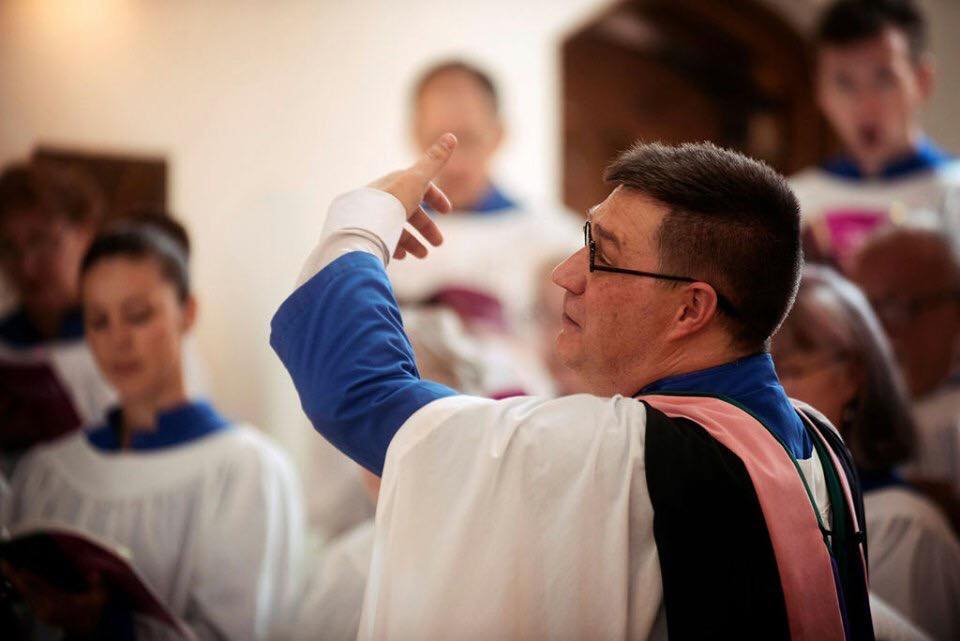
Music
-
Choir
-
Our Organ
-
Musical Leadership
-
Evensong
-
Friends of Music Concert Series
-
St. Martin's Chamber Choir
It is the vision of the St. Andrew’s Music Program to ennoble our collective praise and enhance the beauty of worship at St. Andrew’s through liturgically appropriate musical expression that is prepared with thoughtfulness and rendered with excellence.
“Wherefore with my utmost art, I will sing thee; And the cream of all my heart I will bring thee.”--George Herbert (1593-1633) Anglican Priest and Poet
Led by Choirmaster Timothy J. Krueger and Organist Ralph Valentine, the St. Andrew’s Choir of 35 auditioned singers is one of the finest church choirs in the region and is committed to the Anglican and Catholic musical traditions of the last 1000 years. The level of excellence for which we strive, dedicated to the glory of God and to the building up of God’s Church through worship, is achieved by the laudable effort of musically talented individuals and their commitment to the regular discipline of rehearsals and services as they are held at St. Andrew’s.
The provision of music for Sunday morning Eucharists is the principal sacramental mission of the Choir; however, weekly services of Evensong on Thursdays at 5:45 pm, and a Gregorian chant-based service on Sundays at 5:30pm, are a secondary focus. These meditative services, modeled on the ancient and contemplative offices of monastic Christianity, provide the parish and the downtown Denver community with a weekly opportunity to experience this kind of spirituality. We invite all, even if committed to another church, to experience these services as a supplemental opportunity for worship.
Choral Evensong
Evensong is sung every Thursday (except June-August) at 5:45 pm. in the church. On the first Thursday of every month and other "high" occasions, it is offered by full choir and organ. On the remaining Thursdays a professional quartet fills the resonant acoustics of the church with glorious, generally a cappella music. The repertoire is drawn largely from Anglican sources of the last 500 years, but also occasionally encompasses both older and newer compositions from outside the Anglican tradition.
Still Point Service
The music for the Stillpoint Service, sung on the second and fourth Sunday at 5:30 pm, is drawn mainly from Taize Chant, connecting our modern-day spiritual experience with a timeless and ancient tradition of contemplative, unison singing. A team of volunteers chooses the music selections and provides musical accompaniment for each service. Occasionally a solo instrumentalist (cello, piano, classical guitar, violin, organ, etc.) provides voluntaries before and after the service.
THE CHOIR
Contact Us for more information about joining the choir and the rehearsal schedule
MORE OF OUR SERVICES & MUSIC
FRIENDS OF MUSIC
Upcoming Concerts:
The mention of Madrigals might summon shallow images of "fa la la," but most madrigals were deeply emotional, consummate works of art, combining some of the finest poetry of the Renaissance with very vivid musical imagery. Join us in the church on Saturday, Aug. 3, at 7:00 p.m. for a concert of engaging madrigals, old and new, including two world premieres of new madrigals, performed by a dozen of your favorite singers. The suggested donation is $25 per person, and it includes a delightful evening of music and a wine and cheese reception after the concert. It's a perfect summer evening!
OUR ORGAN
Although little is known of the organs at St. Andrew’s prior to a 7-rank Kimball that was here from the 1950’s through 2001 (which stood on the floor in the baptistery), a November, 2001 fire that started in the undercroft caused extensive heat damage to that organ, rendering it unusable. Choirmaster Krueger immediately convened a committee to investigate options for a new organ, to be installed once the congregation returned following extensive repairs to and restoration of the church building. The result of this committee’s year-long work was the selection of the firm of John Paul Buzard, in Champagne, Illinois, to construct a 20-some rank slider-action organ. In order to maximize floor-space in the back of the church, a platform was constructed in the baptistery to accommodate this organ. Insurance money, together with a capital campaign in 2003, provided $350,000 for this project.
The present Buzard organ (Op. 26) was installed in 2003, with provision for future additions. Several of these (mostly reeds) were added in 2008, but an antiphonal division and several other gaps remained. As the church building itself was expanded in 2008-9, and resulting financial obligations forced a halt to contemplation of further additions, a decision was made to explore other avenues to increase the dynamic range and color possibilities of the instrument, thereby making it more flexible and capable of effectively meeting the demands of a large corpus of organ literature and choral accompaniment. A relatively inexpensive temporary solution was discovered in Hauptwerk, a computer software program that realistically reproduces the sound of a pipe organ by utilizing recordings taken from a real instrument. From a large library of digitally sampled instruments we chose a pipe organ in Chicago built by Ernest M. Skinner in 1928 as being most compatible with the tonal qualities of our Buzard organ. The seamless integration of the two instruments is quite remarkable and has greatly expanded the versatility and registration possibilities for service playing and recitals. Previously unheard voices, such as Chimes, Harp, French Horn, Tuba, and Orchestral Oboe are now readily available, and most parishioners are totally unaware of which sounds are being produced by pipes or the computer. Although we are still hopeful that we will be able to complete the original instrument as planned, we also rejoice in being able to support our excellent music program with our current combination of a traditional pipe organ enhanced with computer generated tonal additions.For a specification of the organ as originally conceived in 2001, please read more about the Buzard Organ here.


